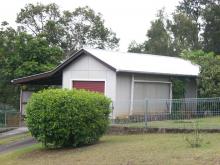- Home
- General information
- How was asbestos used?
Asbestos
How was asbestos used?
Non-friable asbestos (also known as bonded asbestos)
Common forms of non-friable asbestos products include:
- asbestos cement sheeting (e.g. fibro, AC sheeting)
- profiled sheets used on roofs (e.g. Super 6) and walls and flat sheets in flashings
- imitation brick cladding
- roof shingles
- water, drainage or flue pipes
- plaster patching compounds
- textured paint
- vinyl floor tiles
- products such as gaskets, brake shoes, disc pads, clutch housings or elevator brakes.
Asbestos cement sheeting was commonly used in building materials from 1940s to the late 1980s in both domestic residences and other structures and within plant and machinery.
Non-friable materials containing asbestos were often used inside domestic houses for wall sheeting or ceiling sheet, particularly in 'wet' areas such as the kitchen, bathroom and laundry. Asbestos might also be found bonded in plaster patching compounds, textured paint and vinyl floor tiles.
Externally, non-friable asbestos materials containing asbestos were commonly used for roof sheeting and capping, guttering, gables, eaves/soffits, water pipes and flues, wall sheeting and cladding, and flexible building boards. Aside from homes, these products where also used for fencing, car ports and sheds.
Non-friable asbestos materials are the most common asbestos materials in domestic houses. They do not pose a health risk if they are in good condition.
Asbestos can also be found in plant or machinery as gaskets or brake pads. Find out more about the common locations asbestos can be found.
Friable asbestos (loosely bound)
Loosely bound materials containing asbestos are not commonly found in domestic houses. They were primarily used in commercial and industrial settings for fire proofing, sound proofing and insulation, but can be found in some old domestic heaters, stoves, hot water systems and associated pipe lagging and in the backing of vinyl and linoleum floor coverings.
Common forms of friable asbestos materials include:
- sprayed on fireproofing/soundproofing/thermal insulation
- acoustic plaster soundproofing
- thermal insulation (not sprayed on)
- some stage curtain fabrics.
In Queensland, asbestos insulation was not used in residential buildings, although there have been isolated cases in other states.
Friable materials containing asbestos might be found in a few older forms of insulation used in domestic heaters and stoves.
Vinyl sheet flooring sometimes contained friable (loosely bound) asbestos material in the backing of the product (the side attached to the floor) or as an underlay. The vinyl sheet itself does not contain asbestos.
Asbestos-felt was used as a backing for many vinyl and linoleum sheet floorings and does not pose a health risk while it remains undisturbed. However, these materials become loose when the floor covering is damaged or removed and must only be removed by an asbestos removal business that holds an 'A' class certificate.
This product can often be identified by the surface pattern style . It is most often found in buildings constructed before the mid-1980s.
Friable materials, such as the backing of this vinyl sheet flooring are potentially very dangerous because the asbestos fibres can become airborne very easily. These materials must only be handled and removed by an asbestos removalist with an 'A' class asbestos removal licence.

- Home
- General information
- What is asbestos?
- How was asbestos used?
- Are there health effects?
- The risks of exposure
- Health monitoring
- Legislation and codes of practice
- Low density asbestos fibre board
- Asbestos contaminated dust or debris
- Fires
- Cleaning up after floods and storms
- Importation prohibited
- Government and agency roles
- Asbestos in government assets
- Know where asbestos is
- Removing or disturbing asbestos
- Practical guidance
- Resources
- Asbestos alerts
- Asbestos news
- Codes of practice
- Guidance
- Films
- Asbestos safety session 2021
- Asbestos safety session 2020
- Cleaning Asbestos Roofs
- Shadow vacuuming with a H-Class vacuum cleaner
- Use and maintenance of a H-Class vacuum cleaner
- Identifying low density asbestos fibre board hazards and risks
- Working safely with asbestos for the home renovator
- How to properly wear personal protective equipment for airborne contaminants
- Personal protective equipment
- Dear Dad - An asbestos awareness film
- Clear and present danger: Asbestos exposed
- Uses and applications of asbestos - an extract from a film by Parsons Brinckerhoff
- Asbestos health issues - an extract from a film by Parsons Brinckerhoff
- Safe work procedure - storm and wind damage cleanup
- Drilling into asbestos walls and ceilings
- Asbestos - Removing switchboard panels
- Decontamination procedure, personal decontamination and cleanup procedures
- Asbestos awareness
- Safe work procedures
- Preparation before commencing the task
- Preparing and painting corrugated asbestos cement roof and fences
- Drilling into non-friable asbestos using a thickened substance to control airborne fibres and dust
- Drilling into non-friable ACM using an H rated industrial HEPA filter vacuum to control airborne fibres and dust
- Removing a small package electrical switchboard
- Cleanup and disposal
- Safe cleanup of storm damaged materials that may contain asbestos
- Frequently asked questions for homeowners and the general public
- Podcasts
- Strategies
- Working Safely with Asbestos Guide
- Asbestos awareness week 2025
- Asbestos management compliance campaign
- Induction and safety training for unlicensed work
- Sanctions